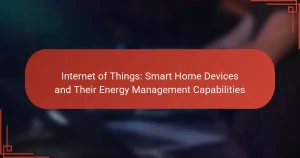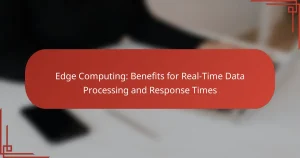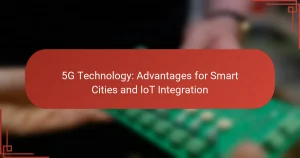Artificial Intelligence (AI) refers to the simulation of human intelligence processes by machines, encompassing learning, reasoning, and self-correction. AI significantly impacts job automation, enabling machines to undertake tasks traditionally performed by humans, which can enhance efficiency and reduce operational costs for businesses. However, this shift poses challenges, including potential job displacement and skill gaps, with estimates suggesting up to 800 million jobs could be affected by 2030. The article explores the implications of AI on workforce dynamics, emphasizing the necessity for continuous learning, reskilling, and the development of both technical and soft skills to adapt to this evolving landscape. Additionally, it highlights the role of organizations in supporting workforce adaptation through training and resources.
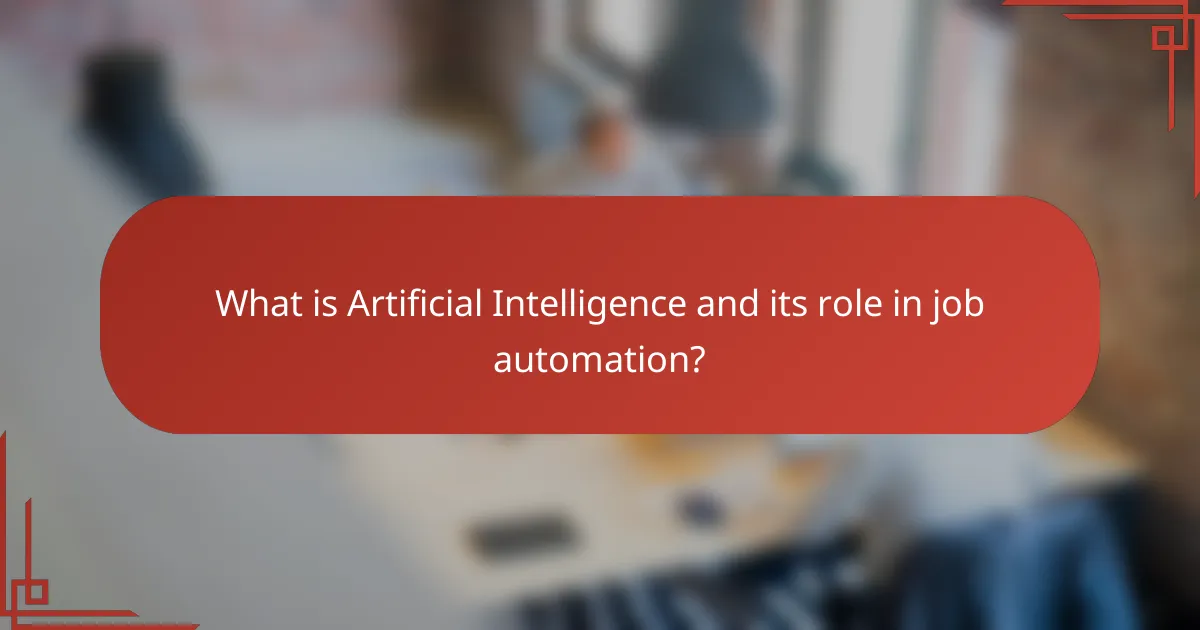
What is Artificial Intelligence and its role in job automation?
Artificial Intelligence (AI) refers to the simulation of human intelligence processes by machines. These processes include learning, reasoning, and self-correction. AI plays a significant role in job automation by enabling machines to perform tasks traditionally done by humans. Automation through AI can increase efficiency and reduce costs for businesses. For example, AI-driven systems can handle data entry, customer service, and even complex decision-making. According to a report by McKinsey, up to 800 million jobs could be displaced by automation by 2030. This shift necessitates a reevaluation of workforce dynamics and skills development.
How does Artificial Intelligence influence workforce dynamics?
Artificial Intelligence significantly influences workforce dynamics by automating tasks and enhancing decision-making. Automation leads to increased efficiency in routine jobs. This can result in job displacement for roles that are easily automated. However, AI also creates new job opportunities in tech and data analysis. A McKinsey report states that by 2030, up to 30% of the global workforce may need to transition to different occupations due to automation. AI enhances employee productivity by providing advanced tools for analysis and workflow management. Furthermore, AI-driven insights can lead to better strategic decisions within organizations. Overall, AI reshapes the workforce landscape by both eliminating and creating jobs, while transforming how work is performed.
What are the key characteristics of Artificial Intelligence that impact jobs?
Key characteristics of Artificial Intelligence that impact jobs include automation, data analysis, and adaptability. Automation allows AI to perform repetitive tasks, reducing the need for human labor in specific roles. Data analysis enables AI to process vast amounts of information quickly, improving decision-making efficiency. Adaptability allows AI systems to learn and evolve, making them suitable for various tasks over time. According to a McKinsey report, up to 800 million global jobs could be displaced by automation by 2030. This highlights the significant impact AI has on the job market and workforce dynamics.
How do different types of Artificial Intelligence systems affect job automation?
Different types of Artificial Intelligence systems significantly affect job automation by varying degrees of task execution and decision-making. Rule-based systems automate repetitive tasks with predefined rules, often in manufacturing and data entry. Machine learning systems analyze data patterns to optimize processes, impacting roles in finance and marketing. Deep learning systems, which mimic human brain functions, enable automation of complex tasks like image recognition and natural language processing. Research indicates that about 47% of jobs in the U.S. could be automated in the next two decades, particularly in sectors like transportation and logistics. This shift necessitates a workforce transition towards more creative and interpersonal roles, as AI takes over routine tasks.
What are the potential benefits of Artificial Intelligence in the workplace?
Artificial Intelligence (AI) in the workplace can enhance efficiency and productivity. AI systems can automate repetitive tasks, allowing employees to focus on more complex responsibilities. This shift can lead to increased job satisfaction and innovation. AI also enables better data analysis, improving decision-making processes. According to McKinsey, organizations that adopt AI can increase their productivity by up to 40%. Furthermore, AI tools can enhance customer service through personalized interactions. This capability can lead to improved customer satisfaction and loyalty. Overall, the integration of AI transforms workplace dynamics positively.
How can Artificial Intelligence enhance productivity and efficiency?
Artificial Intelligence can enhance productivity and efficiency by automating repetitive tasks. This allows human workers to focus on more complex and creative activities. AI systems can analyze large datasets quickly, providing insights that drive better decision-making. According to a McKinsey report, companies implementing AI can increase productivity by up to 40%. AI-powered tools also streamline workflows, reducing time spent on manual processes. Furthermore, AI can optimize resource allocation, ensuring that tasks are assigned to the most suitable personnel. By minimizing human error, AI contributes to higher quality outputs. Overall, the integration of AI leads to significant improvements in operational efficiency across various industries.
What are the long-term economic impacts of Artificial Intelligence adoption?
The long-term economic impacts of Artificial Intelligence adoption include increased productivity and job displacement. AI technologies automate repetitive tasks, leading to efficiency gains across various sectors. According to a McKinsey report, automation could raise global productivity by 0.8 to 1.4 percent annually. This productivity increase can result in higher economic growth and improved living standards. However, AI adoption may also lead to significant job displacement. The World Economic Forum estimates that 85 million jobs may be displaced by 2025 due to automation. This shift necessitates workforce reskilling and adaptation to new job roles created by AI. Moreover, AI can drive innovation, leading to the emergence of new industries and business models. Overall, the economic landscape will evolve, balancing productivity gains with the challenges of workforce transitions.
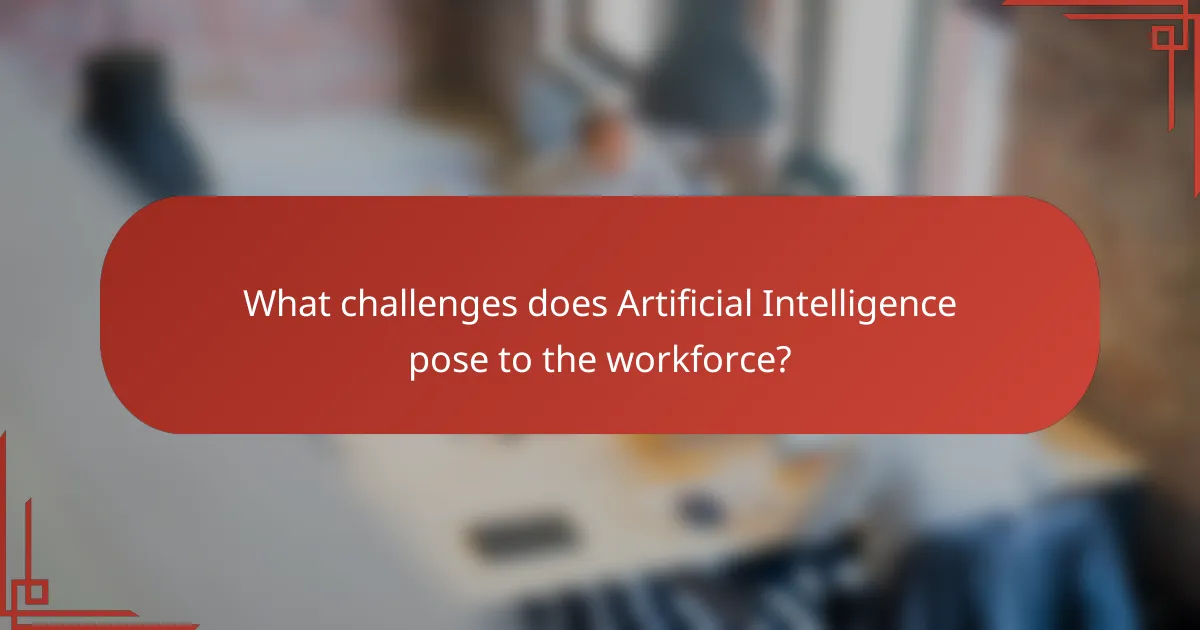
What challenges does Artificial Intelligence pose to the workforce?
Artificial Intelligence poses significant challenges to the workforce, primarily through job displacement and skill gaps. Automation of routine tasks can lead to the elimination of certain job roles. For instance, a report by McKinsey estimates that up to 800 million jobs could be displaced by automation by 2030. Additionally, AI requires new skills that many current workers may not possess. The World Economic Forum predicts that 85 million jobs may be displaced, but 97 million new roles could emerge that require advanced technological skills. This transition creates a skill gap, as education systems may not keep pace with the rapid technological advancements. Furthermore, the reliance on AI can lead to increased job polarization, where high-skill and low-skill jobs grow, but middle-skill jobs decline. These challenges necessitate proactive workforce development strategies to mitigate the impact of AI on employment.
How does job displacement occur due to Artificial Intelligence?
Job displacement occurs due to Artificial Intelligence when machines automate tasks previously performed by humans. This automation can lead to reduced demand for certain job roles. Industries such as manufacturing, retail, and customer service are particularly affected. For instance, AI-driven robots can perform repetitive tasks more efficiently than human workers. According to a report by McKinsey, up to 800 million jobs could be displaced globally by 2030 due to automation technologies. Furthermore, AI can enhance productivity, resulting in companies opting for fewer employees. As AI systems improve, they may take over complex decision-making roles, further displacing skilled workers. The transition may create new job opportunities, but the immediate effect is often a net loss of jobs in affected sectors.
Which job sectors are most vulnerable to automation?
Manufacturing, retail, and transportation sectors are most vulnerable to automation. These sectors involve repetitive tasks that can be easily automated. For instance, assembly line jobs in manufacturing are increasingly being replaced by robotic systems. Retail checkout processes are also being automated through self-service kiosks. In transportation, autonomous vehicles threaten to disrupt driving jobs. According to a McKinsey report, up to 800 million jobs could be displaced by automation globally by 2030. This statistic highlights the significant impact of automation on these vulnerable job sectors.
What skills are becoming obsolete due to Artificial Intelligence?
Repetitive manual tasks are becoming obsolete due to Artificial Intelligence. AI technologies automate jobs that involve routine physical tasks. For example, assembly line work is increasingly handled by robots. Data entry jobs are also declining as AI systems can process information faster and more accurately. Customer service roles are being replaced by chatbots and virtual assistants. Research from McKinsey indicates that up to 30% of work activities could be automated by 2030. Skills related to these tasks are therefore diminishing in demand.
What ethical considerations arise from job automation?
Job automation raises several ethical considerations. One major concern is the potential for job displacement. Automation can lead to significant unemployment in various sectors. According to a McKinsey report, up to 800 million jobs could be displaced globally by 2030. Another ethical issue is income inequality. Automation may disproportionately benefit high-skilled workers while leaving low-skilled workers behind. This can exacerbate existing social inequalities. Additionally, there are concerns about accountability. When machines make decisions, it becomes unclear who is responsible for errors or harm caused. Privacy issues also arise, as automation often involves data collection and surveillance. These considerations highlight the need for ethical frameworks to guide the implementation of automation technologies.
How can we address the fairness and equity of job displacement?
To address the fairness and equity of job displacement, we must implement comprehensive policies. These policies should include retraining programs for affected workers. Evidence shows that retraining can significantly improve employment outcomes. For instance, a study by the National Bureau of Economic Research found that retraining programs can increase reemployment rates by 20%. Additionally, providing financial support during transitions is crucial. This support can help workers manage the economic impact of job loss. Furthermore, promoting equitable access to new job opportunities is essential. This can be achieved through partnerships between businesses and educational institutions. By focusing on these strategies, we can ensure a fairer transition for displaced workers.
What role does policy play in managing the impact of Artificial Intelligence on jobs?
Policy plays a critical role in managing the impact of Artificial Intelligence on jobs. It establishes frameworks that guide the development and implementation of AI technologies. Effective policies can mitigate job displacement caused by automation. They can promote workforce retraining and upskilling initiatives. For example, the European Union’s AI Act aims to regulate AI applications while protecting jobs. Policies can also incentivize companies to create new job opportunities in emerging sectors. Research indicates that proactive policies can enhance job quality and worker satisfaction. The right policies help balance innovation with workforce stability.
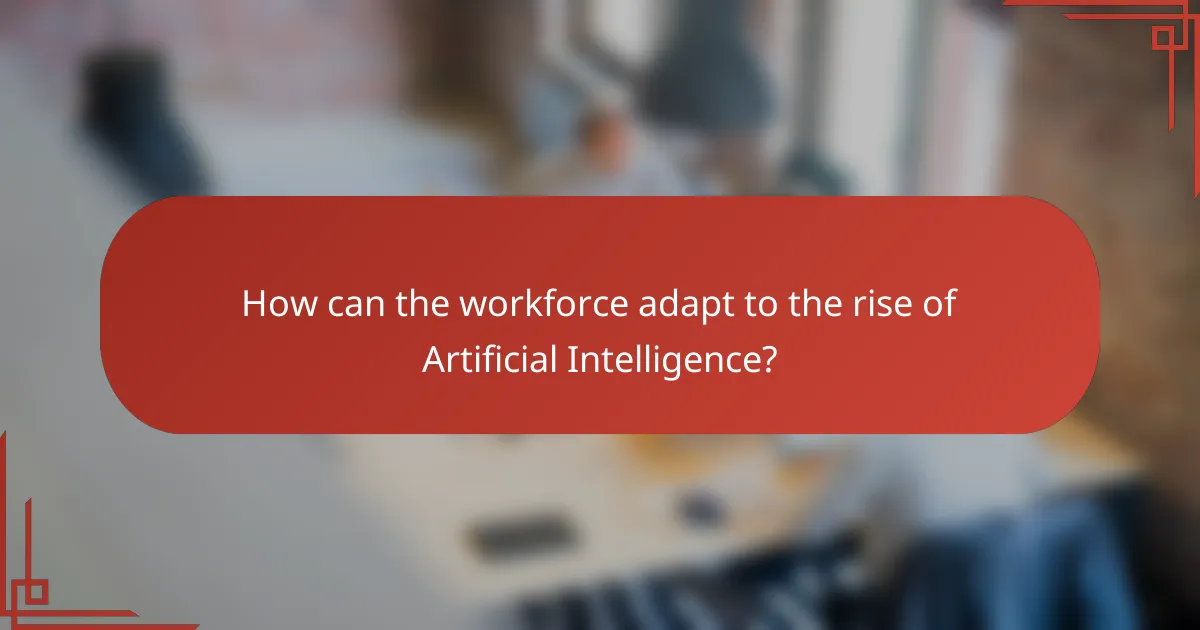
How can the workforce adapt to the rise of Artificial Intelligence?
The workforce can adapt to the rise of Artificial Intelligence by embracing continuous learning and reskilling. Workers should focus on acquiring skills that complement AI technologies. This includes developing expertise in data analysis, programming, and machine learning.
Additionally, enhancing soft skills such as creativity, problem-solving, and emotional intelligence is crucial. These skills are less likely to be automated and are valuable in collaboration with AI systems.
Organizations can support this adaptation by providing training programs and resources. A report from the World Economic Forum indicates that 85 million jobs may be displaced by AI, but 97 million new roles could emerge that require human skills.
Therefore, proactive engagement in lifelong learning will be essential for workforce resilience in the face of AI advancements.
What skills are essential for future job seekers in an AI-driven economy?
Future job seekers in an AI-driven economy need skills such as data analysis, critical thinking, and adaptability. Data analysis enables individuals to interpret complex datasets effectively. Critical thinking is essential for problem-solving and making informed decisions. Adaptability allows workers to thrive in rapidly changing environments. Additionally, proficiency in AI and machine learning is increasingly important. Communication skills are vital for collaboration in diverse teams. Creativity is necessary for innovation and developing new solutions. Emotional intelligence helps in managing relationships and understanding team dynamics. These skills align with industry demands as automation reshapes job roles. Reports indicate that 85 million jobs may be displaced by automation, while 97 million new roles may emerge, emphasizing the need for these skills.
How can workers upskill or reskill to remain relevant?
Workers can upskill or reskill through various methods to remain relevant. Online courses are widely available, covering topics from data analysis to programming. Many platforms offer certifications that enhance employability. Workshops and boot camps provide intensive training in specific skills. Networking with professionals can reveal new opportunities and insights. Employers often support employee development through training programs. Engaging in continuous learning fosters adaptability in a changing job market. According to a report by McKinsey & Company, 87% of workers will need to reskill by 2025 due to automation and AI advancements.
What role do educational institutions play in preparing the workforce for AI?
Educational institutions play a crucial role in preparing the workforce for AI. They provide essential training in AI-related skills. Programs include data science, machine learning, and programming. These courses equip students with theoretical knowledge and practical experience. Institutions collaborate with industry leaders to ensure curriculum relevance. Research indicates that 75% of employers value AI skills in job candidates. Furthermore, institutions foster critical thinking and problem-solving abilities. These skills are vital for adapting to AI advancements. Overall, educational institutions are foundational in developing a competent AI workforce.
What strategies can organizations implement to navigate the transition?
Organizations can implement several strategies to navigate the transition caused by artificial intelligence. First, they should invest in employee training and reskilling programs. This ensures that the workforce is equipped with the skills needed to work alongside AI technologies. According to a World Economic Forum report, by 2025, 85 million jobs may be displaced by a shift in labor between humans and machines.
Additionally, organizations should adopt a phased implementation of AI solutions. This allows for gradual adaptation and minimizes disruption. Creating a culture of innovation within the organization can also facilitate smoother transitions. Engaging employees in the process fosters acceptance and collaboration.
Furthermore, organizations must focus on redefining job roles to complement AI capabilities. This can lead to the creation of new job opportunities. Research from McKinsey indicates that automation could create 20 million to 30 million new jobs by 2030.
Lastly, organizations should establish clear communication strategies. Transparent communication about the changes and their implications helps to alleviate employee concerns. These strategies collectively enable organizations to effectively manage the transition and leverage AI’s potential.
How can companies leverage Artificial Intelligence while supporting their employees?
Companies can leverage Artificial Intelligence (AI) by enhancing employee productivity and providing personalized support. AI tools can automate repetitive tasks, allowing employees to focus on more strategic work. For example, AI-driven software can handle data entry or scheduling, which reduces workload.
Additionally, AI can analyze employee performance and provide insights for professional development. This enables tailored training programs that cater to individual employee needs. Companies can also use AI for employee wellness programs, offering personalized health recommendations based on data analysis.
Studies show that organizations utilizing AI for employee support report higher engagement levels. According to a report by McKinsey, companies that effectively implement AI can improve employee satisfaction by 20%. This demonstrates that integrating AI not only boosts efficiency but also fosters a supportive work environment.
What best practices should organizations adopt for a smooth transition to an AI-integrated workplace?
Organizations should adopt a structured approach for a smooth transition to an AI-integrated workplace. First, they must assess current workflows and identify areas where AI can enhance efficiency. Training employees on AI tools is crucial for fostering comfort and proficiency. Communication is essential; organizations should keep staff informed about changes and expectations. Involving employees in the transition process encourages buy-in and reduces resistance. Establishing clear guidelines for AI usage helps maintain ethical standards and accountability. Continuous evaluation of AI integration ensures that the technology meets organizational goals and employee needs. According to McKinsey, companies that prioritize these practices see a 30% increase in successful AI implementation.
What are practical steps individuals can take to thrive in an AI-augmented job market?
Individuals can thrive in an AI-augmented job market by enhancing their skills and adaptability. Continuous learning is essential. Individuals should pursue relevant courses and certifications in AI and technology. Developing soft skills is equally important. Skills such as critical thinking, creativity, and emotional intelligence are less likely to be automated. Networking within professional communities can provide opportunities for collaboration and growth. Staying informed about industry trends helps individuals anticipate changes. Embracing a growth mindset allows for better adaptation to new tools and processes. Seeking roles that leverage human-AI collaboration can also be beneficial. These steps align with the evolving demands of the job market, where human skills complement AI capabilities.
Artificial Intelligence (AI) refers to the simulation of human intelligence processes by machines, significantly impacting job automation and workforce dynamics. The article explores AI’s role in automating tasks traditionally performed by humans, leading to increased efficiency and potential job displacement, with estimates suggesting up to 800 million jobs could be affected by 2030. Key characteristics of AI, such as automation and data analysis, are discussed, along with the varying impacts of different AI systems on job sectors. Additionally, the article addresses the challenges posed by AI, including skill gaps and ethical considerations, while highlighting the importance of reskilling and policy development in navigating this transition.
